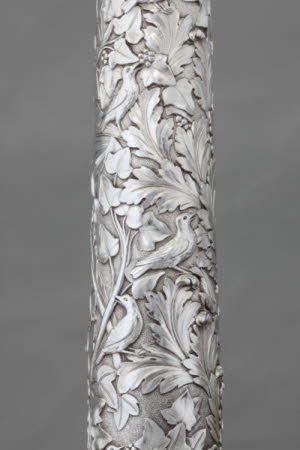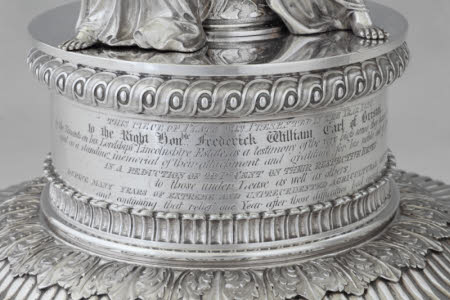Candelabra
John Bridge (1755 - 1834)
Category
Historic Services / Lighting
Date
1826 - 1827
Materials
silver
Measurements
70 x 43 cm; 25 cm (Diameter)
Place of origin
London
Order this imageCollection
Ickworth, Suffolk
NT 852057
Summary
Lincolnshire Tenants Candelabrum. John Bridge, London, 1826/7. Three cast and chased lion’s paw and acanthus foliage feet interconnected by scrollwork and palmettes support a circular waved and ribbed platform with an inner acanthus leaf band. Above is a circular drum on which is engraved on one side a lengthy inscription and on the other a coat of arms (see below). The base of the drum has a cast band of stylised, fluted leaves and there is a pulvinated guilloche frieze. From a plain, flat circular plate on top of the drum rises a cast and chased column with profuse acanthus foliage interwoven with grape-bearing vines and populated by perching and feeding birds. Around the base of the column are three dancing ‘ballerini’ in neoclassical dress and hand in hand (see image overleaf). From the plain capital of the column emanate a calyx of chased drooping acanthus leaves and six reeded, scrolling branches with applied acanthus leaves and flowers which terminate in cast and chased lotus flower sockets. A seventh, conforming socket is on a flaring stiff-leaf stem rising from the centre of the capital. The drip pans are formed as waterleaf coronas. On one side of the drum is engraved a rococo shield showing the arms of Hervey impaling Upton (sable, a cross moline or) with the Hervey supporters and motto beneath an earl’s coronet for the 5th Earl of Bristol. Each of the drip pans is engraved with the Hervey crest and an earl’s coronet.
Provenance
Given to the 5th Earl (subsequently 1st Marquess) of Bristol 1827 by his Lincolnshire tenants; by descent to the 4th Marquess. Acquired by the National Trust in 1956 under the auspices of the National Land Fund, later the National Heritage Memorial Fund
Marks and inscriptions
Side of the drum : ‘This piece of Plate was Presented in the Year 1826 [/] to the Right Honble Frederick William Earl of Bristol, by the Tenants on his Lordship’s Lincolnshire Estates, as a testimony of the very high sense they have of his virtues [/] and as a standing memorial of their attachment and gratitude for his noble act of generosity [/] in a reduction of 20 pr. Cent on their respective Rents [/] (to those under Lease as well as others) [/] during many years of extreme and unprecedented agricultural distress [/] and continuing that relief one Year after those difficulties had ceased.’ Underside: Fully marked with the maker’s mark ‘I.B’ under an imperial crown, lion passant, leopard’s head, date letter ‘l’ and monarch’s head. There are further, conforming marks on other components of the piece. Scratchweight : ‘298 oz"s 8 dwt"s’.
Makers and roles
John Bridge (1755 - 1834), goldsmith John Bridge (1755 - 1834), metalworker
References
James Rothwell, Silver for Entertaining: The Ickworth Collection. Philip Wilson Publishers, 2016, pp. 208-10











